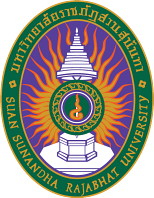Development Process of Plywood Bonding Agent made from Bamboo Scraps.
Keywords:
Plywood Bonding Agent, Plywood Made From Bamboo Scraps, Plywood Manufacturing ProcessAbstract
The research paper presents the results of the development of plywood from the production process of bamboo such as baskets, round bamboo basket, etc., which is a residential occupation in Lum Sum sub-district, Saiyok district, Kanchanaburi Province. However, the production process of plywood was originally required to be heated. The researchers were constantly dependent on the plywood production plant. Therefore, the villagers were looking for substitute materials for plywood bonding agent from the industrial plant. The researchers also tested the proper temperature with the replacement plywood bonding agent and transferred it to the community using a new blend made of latex, foam, wood-based glue, resin, cement. The traditional process of the villagers was carried out by experimenting with wooden boards from new plywood bonding agent and testing them for 5 to 23 minutes during the temperature range 100 - 180 degrees Celsius. The foam is known to provide the best fit for the heating time, temperature range, and thinner. The result shows that when mixed foam 380 g with thinner 300 g, will get the best cementitious solution heat at 90 degrees Celsius, press for 20 minutes, can bear the best weight at 56 kg.
References
Sirin Bunnag, Supakorn Boonyuen and Thanpisit Phuangchik. “A Study on Physical Characteristics of Some Bamboo”, Thai Journal of Science and Technology, Vol 10, No 3, pp 315-326, 2021.
Suthat Dechwisit “Bamboo for bamboo love,” Agro-communica publisher, pp 200, 1994.
Thanpisit Puangchick and Bhornchai Harakotr. “A Survey, Collecting and Characterization of Natural Bamboo in Kanchanaburi Province, Thailand.” Thai Journal of Science and Technology, Vol 7, No 4, pp 382-392, 2018.
Yoosuk, E., Patcharavongsiri, M., Sutchana, K., and Sermsri, N. “Local Product Development for Bamboo Plywood of Kanchanaburi Thailand.” PalArch's Journal of Archaeology of Egypt/Egyptology, Vol 17, No 2, pp 418-429, 2020.
Natpinit, P., Chantrawongphaisal, B., Kongsomboon, C., and Hongcharoensri, P. “Physical Properties of Cement Fibers from Napier Grass,” Udon Thani Rajabhat University Journal of Sciences and Technology, Vol 7, No 2, pp 129-146, 2019.
Wanvipa Chaichan, Aneak Sawain and Weerasak Chaichan. “Optimum Ratio for Co-producing Plant Pot from Organic Residues,” Journal of Southern Technology, Vol.12, No.1, pp 193-205, 2019.
Thailand Industrial Standards Institute “industrial product standards. FLAT PRESSED PARTICLEBOARDS. TIS. 876-2547,” Ministry of Industry, pp 17, 2004.
Premnat Chumprom, Charoon Charoennetkul and Watthanaphon Cheewawuttipong. “Thermal insulation bamboo weaving sheet from wood sawdust/natural rubber composites,” The 27th National Convention on Civil Engineering, Chiang Rai, THAILAND, pp MAT06-1-7, 2022.
Kitchai Jitkhajornwanich. “Adhesive.” NAJUA: Architecture”, Design and Built Environment, Vol 22, pp 93-110, 2007.
Downloads
Published
How to Cite
Issue
Section
License
Copyright (c) 2023 Faculty of Industrial Technology, Suan Sunandha Rajabhat University

This work is licensed under a Creative Commons Attribution-NonCommercial-NoDerivatives 4.0 International License.
บทความที่ได้รับการตีพิมพ์เป็นลิขสิทธิ์ของคณะเทคโนโลยีอุตสาหกรรม มหาวิทยาลัยราชภัฎสวนสุนันทา
ข้อความที่ปรากฏในบทความแต่ละเรื่องในวารสารวิชาการเล่มนี้เป็นความคิดเห็นส่วนตัวของผู้เขียนแต่ละท่านไม่เกี่ยวข้องกับมหาวิทยาลัยราชภัฎสวนสุนันทา และคณาจารย์ท่านอื่นๆในมหาวิทยาลัยฯ แต่อย่างใด ความรับผิดชอบองค์ประกอบทั้งหมดของบทความแต่ละเรื่องเป็นของผู้เขียนแต่ละท่าน หากมีความผิดพลาดใดๆ ผู้เขียนแต่ละท่านจะรับผิดชอบบทความของตนเองแต่ผู้เดียว







